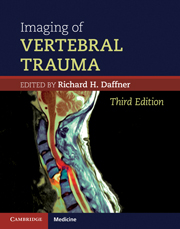Book contents
- Frontmatter
- Contents
- List of contributors
- Preface to the Third Edition
- Preface to the Second Edition
- Preface to the First Edition
- Acknowledgments
- 1 Overview of vertebral injuries
- 2 Anatomic considerations
- 3 Biomechanical considerations
- 4 Imaging of vertebral trauma I: indications and controversies
- 5 Imaging of vertebral trauma II: radiography, computed tomography, and myelography
- 6 Imaging of vertebral trauma III: magnetic resonance imaging
- 7 Mechanisms of injury and their “fingerprints”
- 8 Radiologic “footprints” of vertebral injury: the ABCS
- 9 Vertebral injuries in children
- 10 Vertebral stability and instability
- 11 Normal variants and pseudofractures
- Index
1 - Overview of vertebral injuries
Published online by Cambridge University Press: 21 April 2011
- Frontmatter
- Contents
- List of contributors
- Preface to the Third Edition
- Preface to the Second Edition
- Preface to the First Edition
- Acknowledgments
- 1 Overview of vertebral injuries
- 2 Anatomic considerations
- 3 Biomechanical considerations
- 4 Imaging of vertebral trauma I: indications and controversies
- 5 Imaging of vertebral trauma II: radiography, computed tomography, and myelography
- 6 Imaging of vertebral trauma III: magnetic resonance imaging
- 7 Mechanisms of injury and their “fingerprints”
- 8 Radiologic “footprints” of vertebral injury: the ABCS
- 9 Vertebral injuries in children
- 10 Vertebral stability and instability
- 11 Normal variants and pseudofractures
- Index
Summary
In the course of human history, no injuries have evoked greater fear than vertebral fracture and dislocation. They are among the most devastating of insults and result in a gamut of abnormalities ranging from mild pain and discomfort to severe paralysis and even death. Despite improved technology for the diagnosis and treatment of vertebral fracture and dislocation, the physician who is confronted with a spine-injured patient often feels incapable of interpreting the imaging studies that would delineate the full extent of injury.
This book presents the systematic approach to the diagnosis of vertebral trauma that my colleagues and I have used for the interpretation of images (radiographs, computed tomography [CT] scans, and magnetic resonance [MR] images) of patients suspected of having vertebral injury. Furthermore, it amplifies several concepts that I have developed – namely, that vertebral injuries occur in a predictable pattern, that the imaging findings produced by a generic injury are similar, and that findings for injuries caused by the same mechanism are identical no matter where they are encountered within the vertebral column [1].
This chapter defines the descriptive terms pertaining to fractures and dislocations, reviews the terminology used for reporting these abnormalities, and discusses basic mechanisms of injury. Succeeding chapters discuss anatomy, biomechanics, imaging methods available for diagnosing vertebral injuries, and the basic diagnostic principles that make possible a logical and systematic approach to diagnosing vertebral injuries and to determining whether or not vertebral stability has been maintained.
- Type
- Chapter
- Information
- Imaging of Vertebral Trauma , pp. 1 - 11Publisher: Cambridge University PressPrint publication year: 2011



